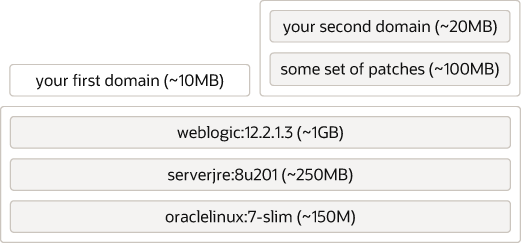Container image layering
Container images are composed of layers, as shown in the following diagram. If you download
the standard weblogic:12.2.1.4 image from the Oracle Container Registry,
then you can see these layers using the command docker inspect container-registry.oracle.com/middleware/weblogic:12.2.1.4
(the domain layer will not be there). You are not required to use layers, but
efficient use of layers is considered a best practice.

Why is it important to maintain the layering of images?
Layering is an important technique in container images. Layers are important because they are shared between images. Let’s consider an example. In the following diagram, we have two domains that we have built using layers. The second domain has some additional patches that we needed on top of those provided in the standard WebLogic image. Those are installed in their own layer, and then the second domain is created in another layer on top of that.
Let’s assume we have a three-node Kubernetes cluster and we are running both domains in this cluster. Sooner or later, we will end up with servers in each domain running on each node, so eventually all of the image layers are going to be needed on all of the nodes. Using the approach shown (that is, standard image layering techniques) we are going to need to store all six of these layers on each node. If you add up the sizes, then you will see that it comes out to about 1.5GB per node.

Now, let’s consider the alternative, where we do not use layers, but instead, build images for each domain and put everything in one big layer (this is often called “squashing” the layers). In this case, we have the same content, but if you add up the size of the images, you get 2.9GB per node. That’s almost twice the size!

With only two domains, you start to see the problem. In the layered approach, each new domain is adding only a relatively very small increment. In the non-layered approach, each new domain is essentially adding the entire stack over again. Imagine if we had ten domains, now the calculation looks like this:
| With Layers | Without Layers | |
|---|---|---|
| Shared Layers | 1.4GB | 0GB |
| Dedicated/different layers | 10 x 10MB = 100MB | 10 x 1.5GB = 15GB |
| Total per node | 1.5GB | 15GB |
You can see how the amount of storage for images really starts to add up, and it is not just a question of storage. When Kubernetes creates a container from an image, the size of the image has an impact on how long it takes to create and start the container.